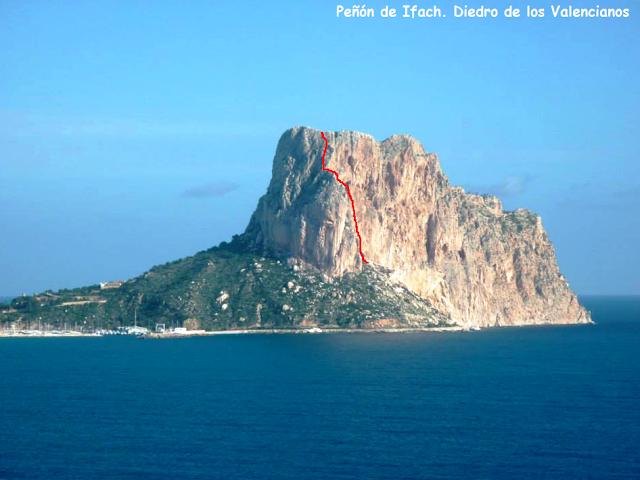Valencianos Route, Peñon de Ifach, Calpe, Alicante, Spain

Hace un tiempo mi padre, Eduardo Teba, y yo planeamos escalar el "Peñon de Ifach", el peñon mas famoso de España. Finalmente llegó el momento y pudimos hacerlo.
A while ago my dad, Eduardo Teba, and me planned climbing the "Penyal d'Ifac", the most famous sea rock in Spain. Finally the time arrived and we could do it.
El lunes por la noche, mi padre me recogió del aeropuerto de Alicante, y pusimos rumbo a Calpe, el pequeño pueblo donde se encuentra el peñón.
On Monday night, my dad picked me up from the Alicante Airport, just after that we headed to Calpe, a little town where the "Peñon de Ifach" is located.
We decided to climb the "Valencianos route", the most classic route, and possibly the most climbed route of the Peñon, because of that there are some parts where the rock is very polished, mainly in the 3rd pitch.
La ruta esta semi equipada, ya que solo hay unos cuantos parabolts y puentes de roca. Las reuniones están bien equipadas con parabolts y anillas de rapel.
The route is poorly equipped, there are only a few bolts and old natural pros. The belay stations are well equipped with bolts and abseiling rings.
El comienzo de la ruta es al final de un pequeño sendero que se encuentra al final del paseo maritimo "Principe de Asturias", el paseo que se encuentra enfrente del puerto (15-20 min desde el aparcamiento).
The beggining of the route is at the end of a little track located at the end of the promenade "Príncipe de Asturias", the one which is in front of the port (15-20 min from the car park).
1º Largo (IV+ 35m): Comienza por unas gradas de roca algo rotas, protegida con algunos parabolts, sigue hacia la izquierda a buscar una especie de diedro bastante roto. Termina en una repisa donde se encuentra la reunión.
1st Pitch (IV+ 35m): It starts on a "rock steps" with very loose rocks, protected with some bolts, it continues to the left looking for a kind of dihedral which is quite broken. It finish on a ledge where the belay station is.
2nd Pitch (IV 35m): The route carries on to the left, going around of a climbable slab, there are no bolts but it is easy, there are some bushes to belay yourself, there are 2 belay stations, we belayed at the second one, the one which is where the dihedral of the route "Polvos Mágicos" ends.
3º Largo (V+ 15m): Es el largo clave de la vía, remontamos una terraza inclinada con unos tablones que evitan en la medida de lo posible la caída de piedras hasta llegar a un par de fisuras que forman una gran uve. Seguimos la fisura de la derecha protegida por un par de parabolts que en unos cuantos metros muy pulidos nos deja en una serie de repisas, que remontamos hasta llegar a la reunión bajo una placa (6a)
3rd Pitch (VI-A0 15m): It is the crux of the route, it goes over a sloping ledge hold with pieces of timber to avoid rockfalling as much as possible. The route continues for a very polished fissure protected with 2 bolts (A0-Aid climbing is reccommendable on this part), the anchor is on a ledge located a couple metters above the fissure.
4º Largo (IV+ 25m): La vía empieza en una placa vertical de 10-12m sin ningún seguro, tras esta placa la vía gira a la izquierda habiendo un cordino en un puente de roca mostrando por donde va la vía, desde el puente de roca hasta la reunión encontramos algún parabolt y puentes de roca. La reunión es bastante cómoda.
4th Pitch (IV+ 25m): The pitch starts on a 10-12m vertical slab with nothing on the wall , once the slab is passed the route turns left, there is a cord in a natural pro showing where the route is, from the natural pro to the belay station there are some anchor points. The belay station is quite confortable.
5º Largo (IV+ 44m): Placa bastante vertical y larga con buenos agujeros, equipada con alguna chapa y cordinos con puentes de roca, aunque el primer cordino se ve un poco a la derecha, la vía va con tendencia a izquierda. La reunión se encuentra en la cima de la arista, pero siguiendo la cresta a la derecha hay otra más cómoda.
5th Pitch (IV+ 44m): Long and vertical slab with good holds, equipped with bolts and some cords in natural pros, although the first cord is a bit to the right, the route tends to go to the left. The belay station is at the top of the arete, but there is a more confortable belay station following the arete to the right.
6º Largo (IV+ 30m): Puede ser escalado por 2 lugares. El primero es un diedro donde al principio hay un cordino en un puente de roca, parece más duro de lo que realmente es, porque hay buenos agarres en la parte de arriba. El segundo es por una travesía que se encuentra a la izquierda del diedro, y que acaba en la parte de abajo de una placa vertical y bastante dura que tiene un clavo en ella.
6th Pitch (IV+ 30m): It can be climbed for 2 places. The first one is a dyhedral where there is a cord at the bottom, it looks harder than it is, because there are good holds at the top. The second one is a little traverse at the left of the dyhedral which ends at the bottom of a quite hard vertical slab where there is a piton on it.
7º Largo (III 30m): Sigue la cresta hasta la cima, hay puntos de aseguramiento.
7th Pitch (III 30m): It follows the arete to the top, there are some bolts to belay.



















No hay comentarios:
Publicar un comentario